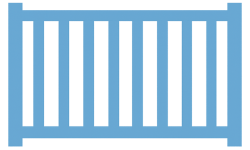We understand that as a homeowner, embracing the DIY spirit can be both empowering and cost-effective. However, installing a Vinyl Fence can seem daunting without the right guidance. If you’re in Salt Lake, Davis, or Utah Counties, you’ve come to the right place for a comprehensive and friendly guide that will make the Installation process smooth and successful.
Understanding the Benefits of Vinyl Fencing
Vinyl fencing has become a popular choice for many homeowners due to its durability and low-maintenance nature. Unlike Wood fences, vinyl does not rot, splinter, or require frequent painting, making it an ideal option for those looking to save time and effort in the long run.
Additionally, vinyl fencing is available in a variety of styles and colors, allowing you to customize the look to match your home’s aesthetic. Whether you want privacy, security, or simply a decorative boundary, vinyl fencing can meet your needs beautifully.
Planning Your Fence Layout
Before diving into installation, proper planning is essential. Start by determining the boundaries and dimensions of your desired fence. This will help you purchase the correct amount of materials and avoid any last-minute modifications.
Consider any slopes or uneven ground in your yard, as these might require special adjustments. Planning your layout in advance ensures a seamless installation process and a polished final look.
Gathering the Necessary Tools and Materials
Having the right tools and materials on hand can make or break your fence installation. Essential tools include a tape measure, level, post hole digger, auger, and a power drill. Don’t forget to have screws, brackets, and Concrete ready for securing the fence posts.
It’s also wise to order a little extra fencing material to account for any mistakes or unexpected adjustments. This preparation step will save you from mid-project trips to the hardware store.
Setting Fence Posts Properly
The stability of your fence relies significantly on properly set posts. Start by marking the spots where each post will go. Dig holes using a post hole digger or auger—these should be deep enough to support one-third of the post’s length.
Once the holes are ready, place the posts and fill them with concrete, ensuring each is level. Allow the concrete to cure fully before proceeding, as this step provides the foundation for the entire fence structure.
Installing Fence Panels
With the posts firmly in place, it’s time to install the fence panels. Begin by attaching each panel to the posts using brackets and screws. Make sure everything is aligned properly to maintain uniformity across the fence line.
Work steadily from one end of the fence to the other, checking alignment frequently. This approach helps avoid any gaps or misalignments that could compromise the fence’s appearance and functionality.
Finishing Touches
Once the panels are in place, it’s time to add any finishing touches. Caps on the fence posts can enhance the overall look and prevent water from collecting inside the posts, which contributes to longevity.
Additionally, consider adding decorative elements such as lattice tops or post lights for added charm. These details can transform a simple Vinyl Fence into an elegant feature of your outdoor space.
Common Mistakes to Avoid
Even the most thorough plans can go awry without careful attention to detail. Avoid some common mistakes by ensuring your post holes are deep enough and the posts level before the concrete cures completely.
Failing to account for temperature expansion can also lead to problems. Leave a little space for the panels to move slightly with temperature changes, avoiding buckling and warping.
Maintaining Your Vinyl Fence
One of the many advantages of vinyl fencing is its low maintenance needs. Regular cleaning with soap and water is often enough to keep your fence looking new. Avoid harsh chemicals to prevent potential damage to the surface.
Inspect your fence occasionally for any signs of wear or damage. Addressing small issues promptly can prevent more significant problems down the line, ensuring your fence remains a reliable barrier for years.
Understanding Local Regulations and Permits
Before starting your installation, it’s crucial to verify local regulations regarding fence height, style, and property line boundaries. Some areas might require a permit for fence installation.
Check with your local government or homeowners association to ensure compliance. Understanding these guidelines in advance will prevent potential fines or the need to make costly modifications later.
Cost Considerations for DIY Vinyl Fence Installation
While a DIY installation can save money, it’s important to realistically assess all potential costs. Calculate the price of materials, tools, and any additional accessories you plan to add.
Compare these costs with professional installation quotes to determine the option that best fits your budget and skill level. This evaluation helps you make an informed decision, balancing cost savings with project complexity.
Quick Tips for a Successful Installation
- Measure Twice – This essential rule helps avoid costly mistakes and ensures your fence line is straight and accurate.
- Level with Care – Keeping everything level during installation ensures a professional look and prevents future structural issues.
- Use Proper Tools – Having the right equipment available not only speeds up the process but also ensures better results.
- Plan for Weather – Install on a dry, calm day to avoid complications from rain or strong winds that could disrupt your work.
- Seek Help if Needed – Don’t hesitate to ask for assistance if you encounter challenges beyond your expertise. A little help can go a long way.
Contact Us for Expert Assistance
If you decide DIY isn’t for you, or need expert advice, our team at Utah Fencing Company is here to help. Contact us by phone at 801-905-8153 or Request a Free Quote today for professional guidance and service you can trust.




